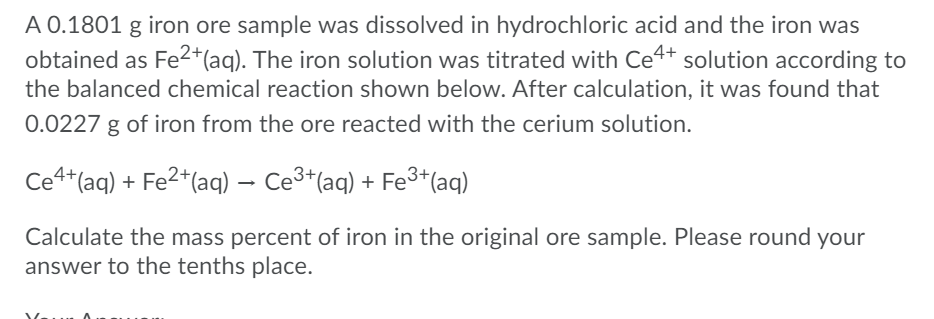A 0.1801 g iron ore sample was dissolved in hydrochloric acid and the iron was obtained as Fe2*(aq). The iron solution was titrated with Ce4+ solution according to the balanced chemical reaction shown below. After calculation, it was found that 0.0227 g of iron from the ore reacted with the cerium solution. Ce4*(aq) + Fe2*(aq) – Ce³*(aq) + Fe³*(aq) Calculate the mass percent of iron in the original ore sample. Please round your answer to the tenths place.
A 0.1801 g iron ore sample was dissolved in hydrochloric acid and the iron was obtained as Fe2*(aq). The iron solution was titrated with Ce4+ solution according to the balanced chemical reaction shown below. After calculation, it was found that 0.0227 g of iron from the ore reacted with the cerium solution. Ce4*(aq) + Fe2*(aq) – Ce³*(aq) + Fe³*(aq) Calculate the mass percent of iron in the original ore sample. Please round your answer to the tenths place.
General Chemistry - Standalone book (MindTap Course List)
11th Edition
ISBN:9781305580343
Author:Steven D. Gammon, Ebbing, Darrell Ebbing, Steven D., Darrell; Gammon, Darrell Ebbing; Steven D. Gammon, Darrell D.; Gammon, Ebbing; Steven D. Gammon; Darrell
Publisher:Steven D. Gammon, Ebbing, Darrell Ebbing, Steven D., Darrell; Gammon, Darrell Ebbing; Steven D. Gammon, Darrell D.; Gammon, Ebbing; Steven D. Gammon; Darrell
Chapter4: Chemical Reactions
Section: Chapter Questions
Problem 4.94QP
Related questions
Question
Answer with units please

Transcribed Image Text:A 0.1801 g iron ore sample was dissolved in hydrochloric acid and the iron was
obtained as Fe2*(aq). The iron solution was titrated with Ce4+ solution according to
the balanced chemical reaction shown below. After calculation, it was found that
0.0227 g of iron from the ore reacted with the cerium solution.
Ce4*(aq) + Fe2*(aq) – Ce3*(aq) + Fe³+(aq)
Calculate the mass percent of iron in the original ore sample. Please round your
answer to the tenths place.
Expert Solution
This question has been solved!
Explore an expertly crafted, step-by-step solution for a thorough understanding of key concepts.
This is a popular solution!
Trending now
This is a popular solution!
Step by step
Solved in 2 steps

Knowledge Booster
Learn more about
Need a deep-dive on the concept behind this application? Look no further. Learn more about this topic, chemistry and related others by exploring similar questions and additional content below.Recommended textbooks for you

General Chemistry - Standalone book (MindTap Cour…
Chemistry
ISBN:
9781305580343
Author:
Steven D. Gammon, Ebbing, Darrell Ebbing, Steven D., Darrell; Gammon, Darrell Ebbing; Steven D. Gammon, Darrell D.; Gammon, Ebbing; Steven D. Gammon; Darrell
Publisher:
Cengage Learning

Chemistry: The Molecular Science
Chemistry
ISBN:
9781285199047
Author:
John W. Moore, Conrad L. Stanitski
Publisher:
Cengage Learning

Chemistry: Principles and Reactions
Chemistry
ISBN:
9781305079373
Author:
William L. Masterton, Cecile N. Hurley
Publisher:
Cengage Learning

General Chemistry - Standalone book (MindTap Cour…
Chemistry
ISBN:
9781305580343
Author:
Steven D. Gammon, Ebbing, Darrell Ebbing, Steven D., Darrell; Gammon, Darrell Ebbing; Steven D. Gammon, Darrell D.; Gammon, Ebbing; Steven D. Gammon; Darrell
Publisher:
Cengage Learning

Chemistry: The Molecular Science
Chemistry
ISBN:
9781285199047
Author:
John W. Moore, Conrad L. Stanitski
Publisher:
Cengage Learning

Chemistry: Principles and Reactions
Chemistry
ISBN:
9781305079373
Author:
William L. Masterton, Cecile N. Hurley
Publisher:
Cengage Learning

Chemistry for Engineering Students
Chemistry
ISBN:
9781337398909
Author:
Lawrence S. Brown, Tom Holme
Publisher:
Cengage Learning

Chemistry: Principles and Practice
Chemistry
ISBN:
9780534420123
Author:
Daniel L. Reger, Scott R. Goode, David W. Ball, Edward Mercer
Publisher:
Cengage Learning

Chemistry & Chemical Reactivity
Chemistry
ISBN:
9781337399074
Author:
John C. Kotz, Paul M. Treichel, John Townsend, David Treichel
Publisher:
Cengage Learning